JQ Magazine: Book Review — ‘Monkey Business Volume 5’

“Monkey Business is a magnetic force that attracts writers who can create magical kingdoms in a single page.” (A Public Space)
By Brett Rawson (Akita-ken, 2007-09) for JQ magazine. Brett is a writer, translator, and Ramen Runner. He has an MFA in Creative Writing Non-Fiction from The New School, and his writing has appeared in Narratively and Nowhere magazine. He is also co-founder of the quarterly publication The Seventh Wave and founder of Handwritten, a place in space for pen and paper.
After reading Monkey Business Volume 5, the image of a blender might pop into your mind. Perhaps this is because it is almost summer and you have recently begun making smoothies in the early morning. Or perhaps this is because you came across the description Monkey Business as genre-defying, which made you think of cross-genre, blending boundaries, and thereafter, the physical image of the object itself: the blender.
But most likely, this is because you read the opening vignette to Monkey Business, “Photographs Are Images,” by rising Japanese writer Aoko Matsuda, which ends as such:
Everything you’ve read up to this point has been images. […] These strings of letters are images. These chains of words are images. Stories are images. The story you’re reading this very minute is an image.
Carefully selected as the opener to Volume 5, this year’s Monkey Business is all about ways of seeing, and perceiving, images and the imagination, and objects and subjects.
JQ Magazine: Book Review — ‘Gon, the Little Fox’
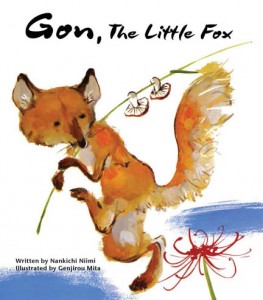
“Written by the legendary children’s book author Nankichi Niimi when he was just seventeen years old, the story brings to life a little rascal who never passes up a chance to cause havoc.” (Museyon)
By Rashaad Jorden (Yamagata-ken, 2008-10) for JQ magazine. A former head of the JETAA Philadelphia Sub-Chapter, Rashaad is a graduate of Leeds Beckett University with a master’s degree in responsible tourism management. For more on his life abroad and enthusiasm for taiko drumming, visit his blog at www.gettingpounded.wordpress.com.
You probably remember reading some of Aesop’s Fables—such as “The Tortoise and the Hare” and “The Boy Who Cried Wolf”—during your childhood. Or more importantly, the lessons those fables are supposed to teach.
Likewise, your students in Japan likely read similar tales, and one of them might have been Gon, the Little Fox. Written by the legendary children’s book author Nankichi Niimi (1913-1943) when he was just seventeen years old, the story brings to life a little rascal who never passes up a chance to cause havoc, like setting fire to rapeseed husks held out in the sun, to dry to stealing a farmer’s cayenne peppers.
However, Gon realizes he’s gone too far when he kills an eel intended to be eaten by the ailing mother of a villager named Hyoju. To atone for his egregious misdeed, Gon repeatedly gathers, among other objects, mushrooms and chestnuts to leave at Hyoju’s house. But Gon’s attempts at forgiveness are never acknowledged and the story ends tragically. (Premature deaths were an unfortunate aspect of Niimi’s life; his mother passed away when he was four and he himself died when he was twenty-nine.)

“By dramatizing some of the people who were on the receiving end of that racial hatred, I think the book might give a concrete sense of what American power can do when it is unleashed against people in other parts of the world. I hope the experiences of Jiro and Mitsuko make readers think twice about that.” (Louis Templado)
By Julio Perez Jr. (Kyoto-shi, 2011-13) for JQ magazine. A bibliophile, writer, translator, and graduate from Columbia University, Julio has had experience working at Ishikawa Prefecture’s New York office while seeking opportunities with publications in New York. Follow his enthusiasm for Japan, literature, and comic books on his blog and Twitter @brittlejules.
A Professor Emeritus of Harvard University, Jay Rubin has also served as a distinguished translator of Japanese literature for more than a quarter century, most notably on the works of Haruki Murakami. June 2 marks the release of his debut novel The Sun Gods (Chin Music Press), which is set in Seattle during World War II and explores the relationships between a Seattle-based Japanese national named Mitsuko and her young adopted American toddler, Billy, who are both interned by the U.S. government at the beginning of the war. Years later, Billy begins a journey to newly reconstructed Japan to find his Japanese mother and learn the truth about their shared past.
As part of the book’s launch, Rubin will be making live appearances from coast to coast, starting with Japan Society in New York on May 7 for an event titled The Magical Art of Translation: From Haruki Murakami to Japan’s Latest Storytellers, featuring other guest authors and moderated by JET alum Roland Kelts (Osaka-shi, 1998-99).
In this exclusive interview, Rubin shares with JQ the legacy of the war on his own writing, the attention to historical detail that went into The Sun Gods (with a few liberties taken), and what makes translating Japanese such a liberating experience.
JQ magazine readers are primarily JETs, JET alumni, and others who have worked and resided in Japan or have a strong interest in the country. Could you tell us about what inspired you to study Japanese language and culture and about any time you spent living in Japan?
In my second year at the University of Chicago, I was going to take one course on something non-Western for the fun of it, and one of the courses that happened to be available was an introduction to Japanese literature (in English translation, of course). I was so fascinated by the literature and by the professor’s remarks on the original language that I immediately started studying that language. I sometimes wonder what would have happened if the course I stumbled into happened to be Chinese history. I spent four years studying the language in Chicago before going to the country itself on a Fulbright fellowship. My spoken Japanese was so bad, all I could say to the young woman bartender at the first bar I wandered into was, “Do you realize you just used the word ‘wake‘ (わけ) three times?” I studied in Tokyo for two years, often wish I had made it four. I’m still remarking on how many times people use wake in sentences. I studied mostly Meiji literature while I was in Tokyo, not Noh drama like The Sun Gods’ Bill, though Noh was a side interest, and I did a lot more work on it in later years.
To start off talking about The Sun Gods, how would you describe your new book to potential readers?
This may sound like ad copy, but I’m comfortable with the summary on the book’s front flap:
Opening in the stress-filled years before World War II, The Sun Gods brings together a white minister to a Seattle Japanese Christian church, his motherless young son, and a beautiful new arrival from Japan with a troubled past. The bombing of Pearl Harbor intrudes upon whatever happiness they might have had together, and the combination of race prejudice and war hysteria carry the action from Seattle to the Minidoka Internment Camp in Idaho. Nearly two decades later, the son is ready to graduate from college when memories of Minidoka and of his erstwhile Japanese mother begin to haunt him, and he embarks on a journey that will lead him from Seattle’s International District to war-ravaged Japan in his attempt to discover the truth about his past.
The internment of people of Japanese ancestry in America that occurred during World War II is rarely dwelled on as much as other events of the war, how would you explain the internment and the reasons it warrants further attention to someone unfamiliar with the topic? What is the most important message you hope to get across?
If there’s a “message,” it’s to convey a historical moment, central to which was the fact that our government established concentration camps within its borders in order to lock up members of a particular racial group, and that this was supported by both public opinion and the Supreme Court with no constitutional justification whatsoever. The government has since apologized openly and eloquently, thus making a repeat performance highly unlikely. Japanese-American organizations, it should be noted, were among the most outspoken against anti-Muslim racism following 9/11.
JQ Magazine: JQ&A with Chin Music Press Owner Bruce Rutledge
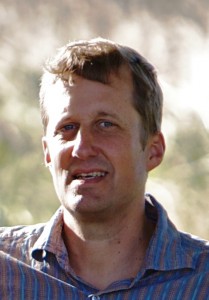
“JETs have a special bond, somewhat like people who go to the same university, and I think returning JETs can exploit that connection to open a few doors. JETs and MEFs are in all sorts of powerful positions these days at multinationals, news agencies, nonprofits, and government jobs. Use that network!” (Courtesy of Bruce Rutledge)
By Julio Perez Jr. (Kyoto-shi, 2011-13) for JQ magazine. A bibliophile, writer, translator, and graduate from Columbia University, Julio is currently working at Ishikawa Prefecture’s New York office while seeking opportunities with publications in New York. Follow his enthusiasm for Japan, literature, and comic books on his blog and Twitter @brittlejules.
After spending a few years in Chiba doing teaching and promotional work that would be all too familiar to JET ALTs and CIRs, Bruce Rutledge went on to work as an editor and writer in Japan for over 15 years. Today, he is the owner of Chin Music Press, a publishing company in Seattle with strong ties to Japan.
In this exclusive interview, Rutledge discusses his time as a Monbusho English Fellow (MEF), which was in some ways a precursor to the JET Program, and shares some of his experiences in a variety of media positions in Japan along with the origin and direction of Chin Music Press.
Since most of our readers are JET alumni, they’re probably already wondering about your connection to JET. Would you mind telling us a bit about the Monbusho English Fellowship you participated in? Why were you drawn to that program? Where in Japan were you placed, and how would you describe your activities as a Monbusho English Fellow? Also, how would you connect MEF with JET and compare it to what JET eventually became?
I was an MEF from 1985 to 1987 in Funabashi, Chiba, I think my job was sort of a combination of a CIR and a teaching assistant. I spent every Monday in the city hall doing PR work for Funabashi, whose slogan was “We More Sports.” I talked to them about this thing called a verb and how their slogan needed one, but my intervention was too late. Tuesday through Friday, I would teach in the schools. I taught a whole year at one high school and spent the rest of the time rotating from middle school to middle school with an occasional elementary school visit thrown in. It was a memorable period of my life. I loved my time there.
Are there any special anecdotes you would like to share from your time in Japan?
Perhaps the time a neighborhood kid of five or six broke into my apartment by climbing through an open window. The little burglar left his shoes on the windowsill. It was just the sort of juxtaposition I love about Japan.
When you finished with MEF, what was your next job? At that time, what direction did you see your life taking, and how did the your path end up differing?
After MEF life, I moved about 15 stops down the Sobu Line to Suidobashi and took a job with Universal News Japan. I was an editor and had planned to have a career in journalism. That plan worked out for nearly 15 years, until the Internet changed everything and I started longing to work in a longer form.
You seem to have had many media-related positions, mostly involving Japan or Asia. How would you describe the kind of work you did post-MEF? During those times, were you living primarily in Japan or somewhere else? How did that impact your performance in those jobs?
I lived in Japan for 15+ years. I never lived in another Asian country. I was a Louis L’Amour of white-collar jobs, doing a little bit of everything. I even did a 15-minute shortwave radio newscast from the bowels of NHK headquarters that aired at 2 a.m. Japan time. We would sleep in bunk beds from 2:30 to 5:00, then do another broadcast at around 5:30. That was the weirdest job I had.
Be interviewed for a book about the JET Program!
Dear American JET Alumni,
I’m writing a book about American alumni of the JET Program and the growing influence of this community on the broader US-Japan relationship. I’m a professor at Indiana University and a JET alum (Shimane, 1993-1995). I’ve already published some research about American alumni of JET and the tremendous potential of this pool of college educated people with on-the-ground experience in Japan. My book will document that influence in a variety of contexts — political, cultural, educational, corporate, etc.
As I work on this book I need your help. I’m interested in talking with American alumni about the various ways they remain involved with Japan after finishing their tenure with JET. Would you be willing to be interviewed for this project?
I’ve set up an online data collection site and am asking that alumni who are willing to be interviewed use that link to provide a few details about themselves so I can determine whom to contact and when, based on my research timeline. This project is authorized by my university’s Institutional Review Board (IRB) and as the first item at the link below indicates, all safeguards associated with such university-approved research are in place.
If you’re willing to share your post-JET experiences and your insights about the growing influence of the American JET alumni community please click on this link (http://bit.ly/1Fvjvof) and provide the requested information (name, contact info, years & position on JET, current job, and nature of continued involvement with Japan). I will follow up with you soon to set up a phone or Skype interview.
If you have any questions about this request or if you’d just like to know more about this book project — I’m always happy to talk about it! — please don’t hesitate to get in touch.
Thanks so much for any insights you can share. I’m looking forward to hearing from you.
Sincerely,
Emily
JQ Magazine: Book Review — ‘Blade’s Edge’
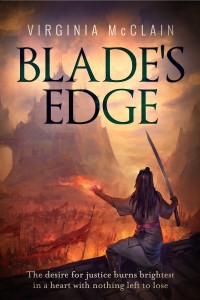
“While Blade’s Edge features challenges for not just the characters, it is fun to see imagination used to create fantasy in an ancient Japan from long, long ago.” (Artemis Dingo Productions)
By Rashaad Jorden (Yamagata-ken, 2008-10) for JQ magazine. A former head of the JETAA Philadelphia Sub-Chapter, Rashaad is a graduate of Leeds Beckett University with a master’s degree in responsible tourism management. For more on his life abroad and enthusiasm for taiko drumming, visit his blog at www.gettingpounded.wordpress.com.
A lot of people (former JETs included) probably feel a lot of things take place in Japan because “that’s the way they have always been.”
So it’s not surprising that mindset would permeate throughout a fictionalized version of the country. Virginia McClain takes readers through such a place in her new novel, Blade’s Edge. Although Japan is blessed with a ridiculously long and rich history that many of us are somewhat aware of, 12th century Japan is probably a complete mystery to even most Japanophiles, but that shouldn’t stop us from imagining what it would have been like. Fortunately, McClain lets her creative and imaginary juices flow, providing readers with a glimpse of a fantasy Japan she created, inspired by her experiences living in Yamagata Prefecture and learning about the country’s history and culture.
The main characters of Blade’s Edge are two young girls named Mishi and Taka. They both reside in Gensokai, the kingdom that serves as the story’s setting (the word “Gensokai”—created from the Japanese terms for element and world—was actually coined for the purpose of the story) in addition to being a territory ruled for more than a thousand years by the Kisōshi, an elite group of warriors…who happen to be all-male.
JQ Magazine: Book Review — ‘Dreaming Spies’
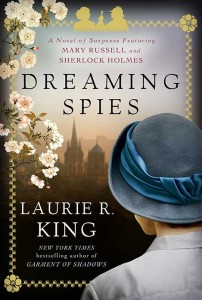
“King sets up an intriguing mystery, with myriad characters with distinctive personalities coming and going, and the conclusion has satisfying twists to keep the formula from being stale.” (Bantam House)
Are detective stories your thing? What about something involving an iconic figure of literature, ninjas, and Japan? Eden Law (Fukushima-ken, 2010-11) of JETAA New South Wales reviews the new mystery novel Dreaming Spies by Laurie R. King, the latest in her Mary Russell-Sherlock Holmes series, which is partially set in Japan and delves into Japanese culture quite a bit.
Picking up another person’s work is never easy, especially if you’re continuing a series of stories long after the original, canonical work ended, and in the time since then has become so popular and well-known that it forms part of modern pop culture. This practice is nothing new and is constantly ongoing—after all, witness the prevalence and popularity (or notoriety?) of fan fiction.
A few years back, a mash-up of high and low culture saw the creation of Pride and Prejudice and Zombies, which kicked off a whole slew of other entries such as Sense and Sensibility and Sea Monsters and Android Karenina…which shows that one way of resurrecting (pun fully intended) a story would be in the vein of a parody. However, rather than an attempt to create something interestingly imaginative (for example, repositioning the Bennet girls from helpless female chattel to arse-kicking women warriors), this genre is more cynically derivative and an attempt to cash into the zeitgeist of the lurching undead—Pride and Prejudice and Zombies, for example, will very soon be out in cinemas. Yay?
I haven’t read any of the other mash-up novels, so Dreaming Spies will be the first I’ve tackled of this growing (sub?)genre. Dreaming Spies isn’t a parody by any means, and its legendary figure of choice is one Sherlock Holmes, although the main master sleuth character here is Mary Russell, who in this story universe is the young wife of a decidedly older Holmes. Probably a wise choice, as tackling a character like Holmes would be like dating someone that just come out of a long-term relationship (i.e., someone that comes with a whole lot of baggage).
JQ Magazine: Book Review — ‘Halfway Home: Drawing My Way Through Japan’

“Through reading her travelogue, Inzer comes across as a writer who would make an excellent travel blogger, as she gives prospective visitors to Japan fascinating tidbits about the country’s culture and attractions.” (Naruhodo Press)
By Rashaad Jorden (Yamagata-ken, 2008-10) for JQ magazine. A former head of the JETAA Philadelphia Sub-Chapter, Rashaad is a graduate of Leeds Beckett University with a master’s degree in responsible tourism management. For more on his life abroad and enthusiasm for taiko drumming, visit his blog at www.gettingpounded.wordpress.com.
You may remember being treated to “What I did during my summer vacation” tales in elementary school. Well, Christine Mari Inzer spent a memorable summer vacation visiting family in Japan and she documents those travels in a largely visual journey titled Halfway Home: Drawing My Way Through Japan.
Halfway Home—so-titled because Inzer, the daughter of a Japanese mother and American father, describes herself as being half at home in the United States and half at home in Japan—summarizes her travels through a collection of photos, illustrations (all self-drawn), and anecdotes. Geared toward young adults (the author is currently a high school senior in Connecticut), Inzer details the ups and downs of travel while humorously detailing some moments of aggravation, such as her frustration with the shyness of Japanese boys.
For young people interested in eventually visiting Japan, Halfway Home provides an introduction to several of the country’s landmarks (the Daibustu in Nara, Kinkaku-ji, in Kyoto, etc.), cultural aspects, and quirks (such as the ubiquity of vending machines). Through reading her travelogue, Inzer comes across as a writer who would make an excellent travel blogger, as she gives prospective visitors to Japan fascinating tidbits about the country’s culture and attractions.
While the journal might have been enhanced a bit with the inclusion of a couple of other aspects of Japanese culture (if Inzer spent a summer in Japan, you would think she surely had to have experienced a hanabi taikai), you don’t have to be a teen to enjoy Halfway Home. Reading about her journey through Japan will surely evoke natsukashii moments for anyone who has spent a lot of time in the country.
Visit Christine’s homepage at http://christinemari.com. For more JQ magazine book reviews, click here.
JQ Magazine: Manga Review — ‘Showa 1944-1953: A History of Japan’
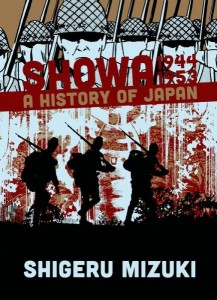
“If you enjoy or are interested in manga and history, or if you appreciate such excellent works as Maus, Persepolis or Barefoot Gen, then this series is a must-read.” (Drawn and Quarterly)
By Julio Perez Jr. (Kyoto-shi, 2011-13) for JQ magazine. A bibliophile, writer, translator, and graduate from Columbia University, Julio is currently working at Ishikawa Prefecture’s New York office while seeking opportunities with publications in New York. Follow his enthusiasm for Japan, literature, and comic books on his blog and Twitter @brittlejules.
Showa 1944-1953: A History of Japan is the third volume in a four-part manga history of the Showa period by eminent manga artist Shigeru Mizuki. (If you’re new to this series, check out JQ’s reviews of the first and second volumes here.)
Since I have already sung the praises of Mizuki’s excellent blending of realistic and comical art and storytelling as well as the top-notch translation by JET alum (and JQ interviewee) Zack Davisson (Nara-ken, 2001-04; Osaka-shi, 2004-06), I have decided to focus this review more on unpacking some of the contents of volume three and providing you with additional resources to look into if you wish to expand your knowledge about any of the topics that appear in the manga, including several wartime tragedies and the postwar occupation of Japan by the Allied Forces.
This volume focuses primarily on the grim latter years of World War II in the Pacific Theater. Despite the fact that Japan’s resources are running far past thin, the government and military persisted in continuing the conflict. This manga puts the spotlight on the plight of soldiers who have become the least important resource to the Japanese government, “Human life is the least valuable resource in the Japanese Army,” Mizuki writes. “Any suggestion that soldiers’ lives have meaning is tantamount to cowardice and treason. Soldiers are tools to be used. And the command’s greatest fear is that soldiers will flee from the enemy—or worse, surrender. They need them more afraid of dishonor than death.”
JQ Magazine: Book Review — ‘Kuma-Kuma Chan, the Little Bear’
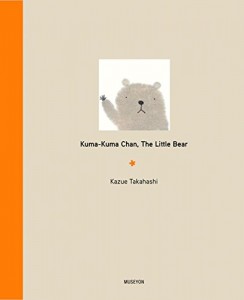
“The simplicity of the storyline and illustrations makes it easy for young readers, and also invites parents and children to dive deeper and create their own dialogue and inquisitions.” (Museyon Inc.)
By Heather Wilson Tomoyasu (Ibaraki-ken, 2004-06) for JQ magazine. Heather is a blogger on her site US-Japan Fam, owner of Miny Moe (multi-brand variety packs that allow parents to find the best brand for their baby), founder of Tunes 4 Bay Ridge Tots, and mommy to her yummy toddler, Kenzo! You can follow and connect with her on Twitter, Facebook, Pinterest, and Instagram.
I’m a sucker for the word chan. Seriously. I don’t know what it is; chan is just so endearing and cute and, well, Japanese!! If you’re a chan-aholic like me, get excited, because there is a new children’s book coming your way that is all about the chan!
The beloved children’s book, Kuma-Kuma Chan, the Little Bear, originally written by Kazue Takahashi and published in Japan in 2001, has just been translated into English, republished by Museyon, and will be available in stores and online Dec. 1 (just in time for those stocking stuffer purchases—hoorah!!). This hardcover book is small, about 5” x 7”, with 52 pages of simple-yet-adorable illustrations and minimal text. The story is short and sweet, with Takahashi describing what she imagines Kuma-Kuma Chan to do every day. With each turn of the page, you are greeted with an illustration and a single sentence describing a different chore or activity, such as shopping, gardening (and sometimes hurting his back), and personal hygiene such as, “He trims the nails of his paws. Then he lines up the cut nails and gazes at them.” I mean, come on, that is kind of hilarious.

“Living in Japan, you learn not just the Japanese language, but a new kinesthetic language as well, such as bowing all the time like it’s an instinct, or getting used to sitting on a tatami mat instead of a chair, or bathing Japanese-style. It’s like a new vocabulary for living in your own body.” (Martin Bentsen/City Headshots)
By Rafael Villadiego (Nagasaki-ken, 2010-13) for JQ magazine. A member of JETAA New South Wales, Rafael is a collector of words on a journey still searching for a destination, who has a tendency to forget, we are all sometimes like the rain…
Lee-Sean Huang (Oita-ken, 2003-06) was an ALT in Nakatsu City. Upon returning to the United States, he became the webmaster for JETAA New York. In 2008, together with Steven Horowitz (Aichi-ken, 1992-94), he helped to found JETwit.com in 2008 as an avenue for connecting and giving voice to the JET alumni freelance and professional community.
A modern-day Renaissance man, Huang is the co-founder and creative director behind the community-centered design and social innovation firm Foossa. He is also a faculty member at SVA’s MFA Design for Social Innovation program and an instructor of the Brazilian martial art capoeira.
He recently joined the Wisdom Hackers collective together with other likeminded artists, activists and entrepreneurs, to which he contributed a chapter entitled “The Thinking Body,” which outlines his views behind the virtues of kinesthetic creativity. In this exclusive interview, Huang shares his journey and thought processes with JQ’s readers.
The philosophical dispatches from Wisdom Hackers are described as an “incubator for philosophers that compiles dispatches from young, edgy thinkers from major cities across the globe.” Can you tell us a little more about this initiative and how you got involved?
We are building a movement for critical inquiry and connecting ancient wisdom to our contemporary context. In our present form, we are partnered with e-publishers The Pigeonhole and releasing a dispatch a week over 10 weeks. Next year, we plan on releasing a limited edition physical book made by monks in Denmark. Beyond publishing our own ideas, we want to create a curriculum or “cookbook” of sorts, and get it into schools, colleges, and other learning environments. The Wisdom Hackers curriculum would provide a starting point for anybody to start asking deep questions, think critically, and create their own dispatch to tell their own story and perspective. The curriculum would also include a guide for how to build your own community of like-minded seekers. That’s a bit of a preview of where we are going with Wisdom Hackers.
My friend Alexa Clay is one of the original instigators of Wisdom Hackers. We were introduced a few years ago through a mutual friend, Alnoor Ladha, who is also a Wisdom Hackers seeker. I ended up becoming an advisor for Alexa’s book, The Misfit Economy, and on her project, League of Intrapreneurs. When Alexa approached me about Wisdom Hackers, I jumped at the idea. I had a bunch of ideas floating around in my head that did not fit in the format of the usual blog posts and articles that I write as part of my design and teaching career. I also liked the challenge of writing longer form content, something I was a little afraid of doing, but that is exactly why I said “yes.”
You are certainly amongst august company. Have you had any direct interaction with the other “seekers” of your collective, or have you developed your ideas primarily on your own?
I have become good friends with the New York-based Wisdom Hackers crew. We hosted a Wisdom Hackers panel discussion here in September. We have edited each other’s dispatches and also have a private Facebook group where we share ideas, so there is lots of cross-pollination happening.
Justin’s Japan: Nippon in New York — ‘Big Hero 6,’ Babymetal, Richie Kotzen, Asa Akira, Perfume
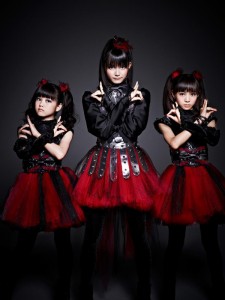
Babymetal brings their unique brand of “kawaii metal” to Hammerstein Ballroom Nov. 4. (Courtesy of WME Entertainment)
By JQ magazine editor Justin Tedaldi (CIR Kobe-shi, 2001-02) for Examiner.com. Visit his Japanese culture page here for related stories.
From Disney to heavy metal to J-pop, November is just as colorful as the leaves tumbling through the air. Add to that a cutting-edge kimono exhibition, a Shakespearean samurai epic, and the largest event in the USA dedicated to love and sex, and you’ve got an irresistibly epic rundown.
This month’s highlights include:
Tuesday, Nov. 4, 7:00 p.m.
Hammerstein Ballroom, 311 West 34th Street
$49.50
Formed in 2010, Babymetal brings a kawaii blend of traditional schoolgirl J-pop and death metal. Hot off the heels of their debut album released in the U.S. earlier this year, the band has been burning up the charts in Japan, where their live video for “Gimmie Choco!!” (lensed at the legendary Nipon Budokan in Tokyo) has racked up over 17 million views on YouTube to date. Endorsed by shredders like Marty Friedman (Megadeth) and Jeff Walker (Carcass) alike, Babymetal are prepared for a whole new audience on the eve of their Hammerstein debut.
Wednesday, Nov. 5, 7:30 p.m.
B.B. King Blues Club and Grill, 237 West 42nd Street
$28-$32
With guitar styles ranging from rock, blues, jazz and fusion to pop and soul, Richie Kotzen has built a remarkably diverse 25-year career as a guitarist, singer and songwriter. A veteran of numerous groups including the Winery Dogs, Kotzen’s Japan cred is extensive: He wrote the number one song “Shine” as a member of Mr. Big, which was used as the ending theme for the anime series Hellsing, has recorded an entirealbum of music from the anime series Gundam, and toured as the opening act on the Japanese leg of the Rolling Stones’ 2006 tour. The Kotzen Telecaster guitar has repeatedly been the #1 selling signature model guitar for Fender Japan. This special solo show will include selections from The Essential Richie Kotzen, the artist’s latest release, which caps a career of highlights in anticipation for his next studio album coming next year.
Nov. 6-12
Nippon Club Gallery, 145 West 57th Street
Free
Kiyomi Kitagawa, a popular fashion designer and a representative of Atelier Bi-no-Sei, revives stylish and practical design dresses in harmony with modern lifestyle from traditional craftwork, a microcosm of Japanese sensibility that has been shaped by the passing of the “four seasons” since ancient times. These dresses show not only the “craftsman’s spirit” by seasoned artisans, but also her knowledge and experience as a textile garment designer. At this exhibition, 30 pieces of kimono dresses—some using fabric no longer produced—will be displayed with luxurious embroidery and a variety of techniques.
For the complete story, click here.
JQ Magazine: Book Review — ‘Starting Point: 1979-1996’ by Hayao Miyazaki
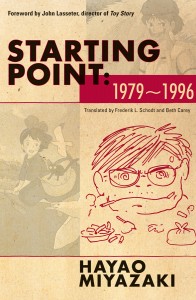
“For those who enjoy the process and precision behind an art, Starting Point is a rare glimpse into an often-times enigmatic industry.” (VIZ Media LLC)
By Alexis Agliano Sanborn (Shimane-ken, 2009-11) for JQ magazine. Alexis is a graduate student of Harvard University’s Regional Studies—East Asia (RSEA) program, and currently works as an executive assistant at Asia Society in New York City.
Starting Point: 1979-1996, translated by Beth Cary and Frederik L. Schodt, is quite unlike its sequel, Turning Point: 1997-2008 (read JQ’s review here). Technical rather than creative, Starting Point shares renowned director Hayao Miyazaki’s recollections of his early days as an animator. The essays and interviews follow anime through production development, touching on the intricacies of character design, layout, and story adaptation. For those who enjoy the process and precision behind an art, Starting Point is a rare glimpse into an often-times enigmatic industry.
The first half of the work features essays on Miyazaki’s long hours in the studio, culture, and nature of Japan’s animation industry in the 1960s and 1970s. As Miyazaki notes, even then, anime was tied to media mix marketing. You didn’t just have manga; you had manga, then an anime, toys, merchandise, and spin-offs all fueling off each other. Says Miyazaki in a 1982 interview: “The world of anime makes its business out of themes like departing for new horizons or love, while pretending not to be conscious of [the] commercial reality.” In hindsight, these remarks prove ironic; the auteur’s Studio Ghibli having similarly succumbed to commercialization.
It isn’t just media mix that remains the same today: professional frustrations were high and work-life balance poor. Miyazaki, over the course of several essays, recounts the life of a young professional. He states: “When young, nearly all of us want to be taken seriously, as soon as possible….In fact, many of those who have not yet taken the plunge into the professional world…tend to speak endlessly about techniques, or concentrate on gaining as much knowledge as possible….In reality, however, once you enter this industry, the techniques required can be mastered very quickly.”
Getting Unstuck: How To Turn Your Dreaming Into Doing
Jonathan Bissell (Chiba-ken, 1995-2000) is the author of Dream in Color, Think in Black & White: How to Get Unstuck and Fulfill Your Dreams. He is also the CEO of High Performance Impact, LLC, an executive coaching firm helping proven and emerging leaders to identify and consistently leverage patterns of high performance.
You’re a writer and you have a book inside you, but it doesn’t know how to get out.
Here are 3 simple steps to begin getting your book out of your head and where it belongs, on paper.

3 Simple Steps To Begin Writing Your Book:
- STEP #1: Write Your Introduction. Writing begins with…writing. It sounds silly, but just sitting down to write is the one simple step that many people never take. So take it. Grab a paper and pen, or your laptop, and sit somewhere comfortable. Now imagine we’re sitting there together, and I ask you to tell me about your book. “What’s your book about?” I ask you. Now write or type your answer. That’s it. Just tell me about your book. If it’s helpful, try to answer questions such as Who, What, When, Where, Why and How. Once you’re finished, you’ll have created the Introduction to your book! Now on to step #2.
Continue reading here.
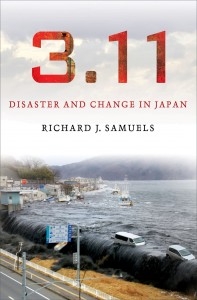
“Samuels draws from historical precedents and a rich and meticulously researched source material, as well as his extensive experience as a long-time observer and commentator on Japan, to produce a compelling and thought-provoking attempt to examine the true impact of the 3.11 disaster.” (Cornell University Press)
By Eden Law (Fukushima-ken, 2010-11) for JQ magazine. Eden currently serves on the JETAA New South Wales committee in Sydney, Australia as the online social media, webmaster and occasional editor. Got feedback? Leave a comment below.
The natural and man-made disaster of the 2011 Tohoku earthquake provoked an intense and visceral response from within and without, which saw an unprecedented level of cooperation between allies and between former enemies, and a united outpouring of human generosity and spirit globally. Little wonder then, that the usual cynical rhetoric was replaced with wholly credulous proclamations of a new age that could be an economic, technological, political and social rebirth of a nation.
“We expect a lot from crises,” author Richard J. Samuels notes in 3.11: Disaster and Change in Japan’s preface, and confesses to have himself been caught up in that same wave of optimism. What would the actual consequences be from the disaster? Would it bring a new era of “revival,” one of a number of slogans touted around Japan in the months following 3.11, or would the goodwill and its accompanying momentum evaporate in the face of reality that brings with it the problems of coping and dealing with a humanitarian disaster?
Samuels draws from historical precedents and a rich and meticulously researched source material, as well as his extensive experience as a long-time observer and commentator on Japan, to produce a compelling and thought-provoking attempt to examine the true impact of the 3.11 disaster. Starting with a description of the state of Japan around the time of the event, he describes a country in the economic doldrums, far from its position that it occupied decades earlier as an economic powerhouse that was the envy (and fear) of the developed world. Politically, Japan’s government had become a circus of ever-changing prime ministers, resulting in low public confidence in its leaders. Little wonder, then, that when the calamity of March 11th struck, the expectation and need for change seemed especially urgent and indeed, possible, more than at other time in recent Japanese history.

